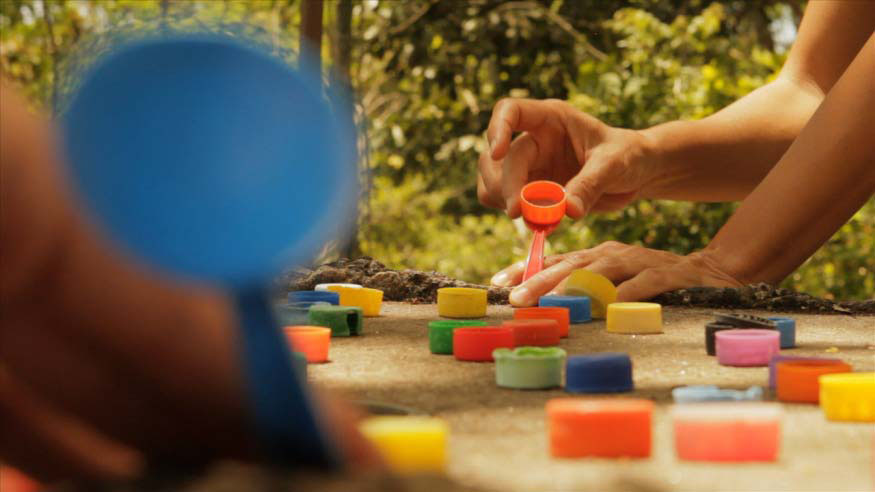Palo Enceba’o María Chiquita
2016 - Photography (Photography)
54 3/10 x 44 9/10 inches
José Castrellón
Palo Enceba’o is a project by José Castrellón composed of three photographs, two drawings on metal, and a video work that creates a visual and cultural analogy between the events of January 9th, 1964 in Panama City and the game of palo encebado carried out in certain parts of Panama to celebrate the (US-backed) independence from Colombia. In the game, young men climb a wood post smeared with animal wax to collect a Panamanian flag in return for a bounty. During what is now remembered as Martyrs’ Day, Panamanian students trespassed the fence that separated the American-governed strip of land along the Panama Canal and Panama City to fly a flag and symbolically claim sovereignty over the area that had been turned over to the United States by the Hay–Bunau-Varilla Treaty in 1903. Effectively, the treaty allowed for the construction of the canal and its use in perpetuity by the US in exchange for a sum of money and the backing of Panama’s independence from Colombia. Dubbed as a threat to the sovereignty of the Canal Zone, the American military shot and killed several of the students involved in the incident (declared martyrs) which escalated the already tense relationship between the countries and eventually aided in the negotiations of the Torrijos-Carter Treaties that returned the Canal Zone to Panama. The image of the students climbing up a light post is likened to the palo encebado game. Through the appropriation of a photograph by Stan Weymann published on the cover of TIME Magazine in January 1964 and two original images, the series Palo enceba’o speaks of the ambiguity of the notion of sovereignty.
José Castrellón works with photography, video, found material and language, moving between the conceptual and documentary realms. Through research, he takes history as a point of departure to inquire into and express anthropological and sociological concerns. He identifies with cultural changes and the impact they have on different places, the cultural modification of people and society, as well as the physical transformation of landscapes, brought about by commercialism, colonialism, geopolitical conflict, and interventions. Castrellón practice is concerned with diffusion, hybridization, and exposure to different cultural forms and their imposition, appropriation, or cannibalism, which emerge on the faces of people or the nature of spaces.
Colors:
Other related works, blended automatically
» see more

© » KADIST
José Castrellón
2016Palo Enceba’o is a project by José Castrellón composed of three photographs, two drawings on metal, and a video work that creates a visual and cultural analogy between the events of January 9th, 1964 in Panama City and the game of palo encebado carried out in certain parts of Panama to celebrate the (US-backed) independence from Colombia...
Related works sharing similar palette
» see more

© » KADIST
Tony Oursler
2012Continuing Oursler’s broader exploration of the moving image, Absentia is one of three micro-scale installations that incorporate small objects and tiny video projections within a miniature active proscenium...

© » KADIST
Eric Dizambourg
2010Like the film Le Mouton noir, this dimension is counterbalanced by a burlesque element...
Other works by: » José Castrellón
» see more

© » KADIST
José Castrellón
2016Palo Enceba’o is a project by José Castrellón composed of three photographs, two drawings on metal, and a video work that creates a visual and cultural analogy between the events of January 9th, 1964 in Panama City and the game of palo encebado carried out in certain parts of Panama to celebrate the (US-backed) independence from Colombia...

© » KADIST
José Castrellón
2016Palo Enceba’o is a project by José Castrellón composed of three photographs, two drawings on metal, and a video work that creates a visual and cultural analogy between the events of January 9th, 1964 in Panama City and the game of palo encebado carried out in certain parts of Panama to celebrate the (US-backed) independence from Colombia...
Related works found in the same semantic group
» see more

© » KADIST
Donna Conlon and Jonathan Harker
2012In Tapitapultas (2012), Donna Conlon and Jonathan Harker comment on mass consumerism and pollution by way of a game they invented...

© » KADIST
Prabhakar Pachpute
2020Calling attention to campaigns for land rights, survival, and sovereignty, Prabhakar Pachpute’s recent works consider how farmers in India use their bodies in performative ways during acts of protest...

© » THEARTNEWSPER
Was Rauschenberg’s grand prize win at the 1964 Venice Biennale a US plot, or just good PR? Art market Museums & heritage Exhibitions Books Podcasts Columns Technology Adventures with Van Gogh Search Search Film review Was Rauschenberg’s grand prize win at the 1964 Venice Biennale a US plot, or just good PR? A new documentary delves into the machinations that led to the upstart American artist’s stunning triumph at the art world’s Olympics David D'Arcy 15 December 2023 Share Robert Rauschenberg (right foreground) receives from Italian Minister of Education, Luigi Gui (left foreground), the top prize for the best foreign painting at the Venice Biennale in 1964 Associated Press / Alamy Stock Photo In 1964, the American artist Robert Rauschenberg was awarded the grand prize at the Venice Biennale...



